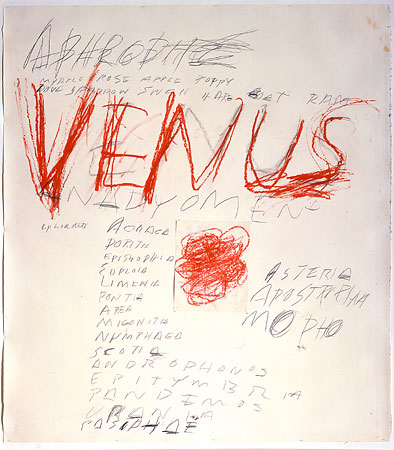Cy Twombly, a controversial American artist whose deceptively simple scrawls, smudges and sculptural shapes made him one of the most significant artistic figures of the past 50 years, died July 5 in Rome. He was 83 and had cancer.
Mr. Twombly, a native of Lexington, Va., spent most of his adult life in Italy, where he forged an original artistic path in spite of early criticism and outright mockery.
Along with artists Robert Rauschenberg and Jasper Johns, Mr. Twombly was considered an heir to the mantle of Abstract Expressionist painter Jackson Pollock.
Mr. Twombly painted vast canvases marked by smears of paint, half-erased graffiti, random scratches and occasional lines of poetry that evoked a connection between the world of classical mythology and the vibrant street culture of modern life. But he was nothing if not polarizing.
In 1994, England’s Guardian newspaper pronounced him “the last great American artist.” The same year, Washington Post art critic Paul Richard dismissed Mr. Twombly as a “self-indulgent scribbler” whose “handwriting suggests a 6-year-old dyslexic’s.”
One of his leading proponents, Kirk Varnedoe, a former curator at New York’s Museum of Modern Art, wrote in a 1994 essay that “Twombly is the original ‘My kid could do this’ sculptor and painter.”
In Houston, where an entire gallery is devoted to Mr. Twombly’s work, a headline in the Houston Chronicle in 2005 summed up the divided view of his reputation: “Is Cy Twombly one of the greats? Or the wretched embodiment of everything wrong with modern art?”
Mr. Twombly occasionally worked in collage and sculpture, but he was known mostly for his paintings and drawings. An important series of paintings from 1967 to 1970 — some measuring 10 feet high and 32 feet wide — were starkly reminiscent of a blackboard with geometric shapes, numbers and scrawls of handwriting.
He sometimes scratched the canvases with his fingernails or used pencils, palette knives or brush tips to leave lines in the paint, prompting poet Frank O’Hara to write in 1955: “A bird seems to have passed through the impasto with cream-colored screams and bitter claw marks.”
Other paintings were linked to the classical past and named after Greek and Roman gods. Many of his early works were dismissed as doodling on canvas, but over time many critics came to praise Mr. Twombly’s distinctive, quirky vision. He influenced younger artists, including Anselm Kiefer, Francesco Clemente and Julian Schnabel, and his works often sold for millions of dollars.
His paintings “seem barbarically formless, yet are perversely graced with sensitive touch and texture,” critic Peter Schjeldahl wrote in the New Yorker in 2005. “To make a persuasively meaningless mark is harder than it looks. Your little kid can’t do it.”
Edwin Parker Twombly Jr. was born April 25, 1928, in Lexington, where his father was a longtime athletic coach at Washington and Lee University.
His father, who briefly pitched for the Chicago White Sox in 1921, had the nickname Cy, and his son became known as “Little Cy.”
The younger Twombly spent his childhood in Virginia and spoke with a Southern accent, but he was descended from old New England families and spent his vacations in Bar Harbor, Maine, and Palm Beach, Fla.
As a child, he was fascinated by Greek and Roman mythology, and by his teens he had begun to paint. He studied at the Boston School of Fine Arts, Washington and Lee, and the Art Students League in New York, where he met Rauschenberg.
In 1951, at Rauschenberg’s suggestion, Mr. Twombly attended the progressive Black Mountain College in North Carolina, where he studied under painters Robert Motherwell and Ben Shahn and befriended iconoclastic French artist Franz Kline.
Motherwell called Mr. Twombly “the most accomplished young painter whose work I happen to have encountered.”
With a grant from the Virginia Museum of Fine Arts in Richmond, Mr. Twombly spent a year with Rauschenberg in Rome and Morocco, where he worked an archaeological dig of Roman ruins.
After he was drafted into the Army in 1953, Mr. Twombly rented a studio and often painted at night with the lights turned out. He taught at a junior college in Buena Vista, Va., for a year, then traveled to Italy in 1957 and settled there.
He married Tatiana Franchetti in 1959 and had a son, Cyrus Alessandro Twombly. His wife was from a wealthy family, and together they owned an apartment in Rome and three villas in Italy.
In the early 1990s, Mr. Twombly bought a house in his home town of Lexington, where he quietly spent half of each year.
One of his final works was completed in 2010, after officials of the Louvre museum in Paris asked him to paint the ceiling of a sculpture gallery.
Mr. Twombly seldom spoke to the press, even when a major exhibition of his sculpture was shown at the National Gallery of Art in 2001.
In one of his rare interviews, with Vogue magazine in 1994, he said: “I swear if I had to do this over again, I would just do the paintings and never show them. And then after I’m dead, they could talk about them all they want.”






